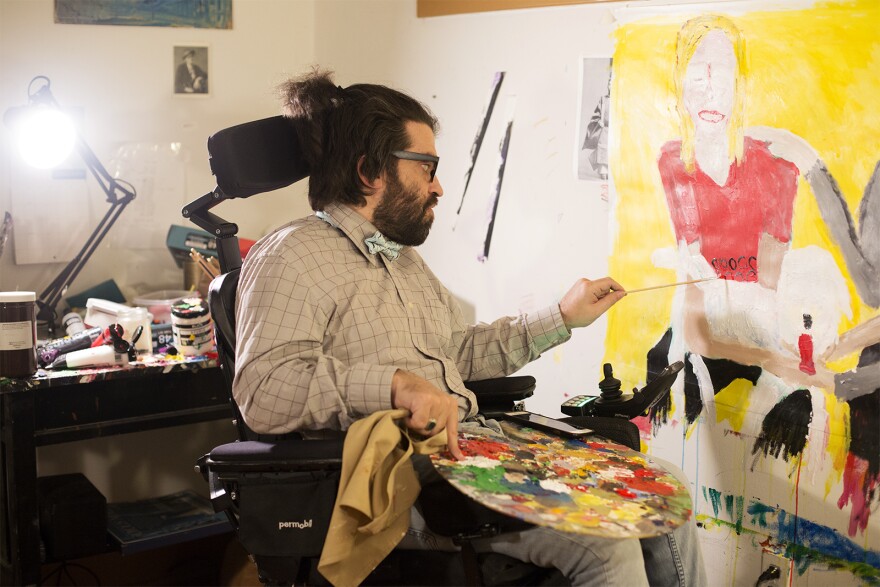All artists use their unique abilities and experiences in their work. Chris Worth is no different.
But Worth’s art is informed by a more complicated set of realities than most. Born in Connecticut along with a twin brother, Worth was diagnosed at birth with cerebral palsy. When he was 1, his mother had a stroke.
At first, a family friend cared for him. After that, he bounced through several foster families and an educational system that put him on a path toward unskilled labor. At 11, he was adopted by a West Virginia couple who saw his potential as a student and artist.
But even in a stable home, he was confused by his attractions toward women and men, an orientation for which he now uses the word “queer.” "Disabled" is the one-word description he prefers in talking about his cerebral palsy. They're part of a long list of identities folded his art.
“I also have tons of privilege as a white man, and I’m sort of wrestling with that privilege,” said Worth, 40. “But I was also in foster care, so that kind of struggle that I had up until I was 11 impacts how I'm going to approach what stories I want to tell.”
‘I cried a lot’
Worth’s cerebral palsy makes painting a more deliberate process than it is for many other artists.
“I literally have to convince my arm to make a mark,” Worth said. “And sort of the positioning of the wheelchair might also impact how I reach out with the brush.”
He began painting at 6, fascinated by a new set of watercolors and what his sometimes-unpredictable hands could create. At 12, he began painting with oils. But when he began college at Marshall University in Huntington, West Virginia, some of his art professors said he’d never make it because of his disability.
“Honestly, I cried a lot. I stayed after class longer than most people; I lived in the studio,” Worth said. “And I relied on the people who supported me.”

Worth earned a bachelor’s degree and then a masters.
These days, for critical input, he sometimes turns to his life partner Julie Salih, who is visually impaired but has a good eye for shapes. They share a direct style of communication.
“I might say, 'Literally, it looks like a black blob,’” Salih said.
Worth rarely holds back in his replies, sometimes telling Salih that the problem is she “can’t see it.” But he appreciates her input.
“I know that if she can see at least a part of what I'm trying to convey, then I'm doing an excellent job,” Worth said.
Red ties and real power
Besides making art, Worth works as a team manager at Paraquad, an agency that provides services for people with disabilities, including connecting them with in-home care, housing and employment.
The strength of clients' collective efforts recently inspired him to examine ideas about power, in a series called the Red Tie Series. The red ties represent hyper-masculinity and the historical dominance of men over women.

“In this series, I’m laying bare that what we think of as real power is really oppression,” Worth said. “Real power lies in … being able to come together.”
In one of 17 paintings, a female figure stands behind a male one, sewing his abdomen with needle and thread, as if to place a heart — a very small one — into his body.
“Maybe she’s saying, ‘You don’t even deserve this little piece,’” Worth said.
Details make it apparent that she is the one in control.
“His eyes are sort of rolling back in the back of his head, like he’s either like being healed or his life force is being taken away,” Worth said. “A red tie is flung from him all the way over her shoulder, so in a way, it’s playing a very physical role in making the transference of power.”
‘Just want to keep doing it’

Worth has a unique style, according to St. Louis artist and art educator Gina Alvarez, who curated his work for an exhibition at the Regional Arts Commission.
“The way he places figures in space, the way he uses color to kind of … manage those figures in space and create some sort of sense of atmosphere are what drew me to his work,” Alvarez said.
Worth’s portraits, in particular, demonstrate his love and generosity, Alvarez said.
“When he gets the opportunity to paint someone or tell a story about someone in his life, we get to see a tenderness that is only felt through the painting that he makes,” said Alvarez, executive director of VSA Missouri, an organization dedicated to the arts and people with disabilities.
Worth, a former president of VSA’s board of directors, is currently exhibiting in a show at his college alma mater and has about 100 works in private, individual collections. He looks forward to the day he can earn more of his income from making art.
“But mostly, I just want to keep doing it,” he said.
Follow Nancy Fowler on Twitter: @NancyFowlerSTL
Send questions and comments about this story to feedback@stlpublicradio.org




